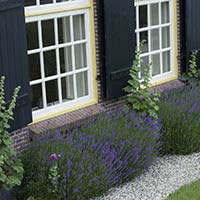Mulch vs. Rocks
In central Kansas, we typically endure long, hot summers that don’t provide enough rain to keep our flowers, trees and shrubs happy.
Many homeowners use bark mulch around plants to help retain moisture, insulate soil from cold and heat, keep weeds away, and minimize erosion. When planning your home’s landscaping, it’s important to consider whether to use rock or an organic mulch like tree bark for ground cover. Both options have aesthetic and functional value, but the primary concern should be what’s best for your plants.

Bark Mulch
This is the most common type of mulch, which is typically made by shredding the bark of cedar, cypress, pine, hemlock, eucalyptus and oak trees.
Benefits of Bark Mulch
Less watering – According to a study by the University of California, organic mulch like bark or wood chips held up to 3 and a half inches of water per foot of mulch.
Color choices – Bark mulch can be dark brown, black or red
Inexpensive – Installed cost is around $0.70 – $0.80 per square foot
Easy for a do-it-yourselfer to install using simple gardening tools like a shovel or rake
Doesn’t require edging or weed barrier
Adds nutrients to soil as it decomposes; however, it’s no substitute for good soil fertilization
Disadvantages of Bark Mulch
- Must be replaced every year or two
- Bark mulch is flammable and can attract insects
- Can be washed away by heavy rains
- Color will fade from sun exposure over time
When to Use Bark Mulch
For garden beds and ornamental plantings, shredded bark mulch is generally recommended. It works well around annuals, because you can easily dig through the mulch to add or remove plants. A layer of mulch around plants in the fall is also recommended to protect them from the freezing temperatures and harsh wind of Kansas winters.

Rock Mulch
Any type of decorative gravel can be used as groundcover, including lava rock, quartz, granite, pea gravel, and river rock. This landscaping gravel can be anywhere from the size of a pea up to golf ball size.
Benefits of rock mulch
Long-lasting, never needs replaced
Lower cost over time – Rock mulch is a one-time expense
Variety – Many colors, shapes, and sizes available
Disadvantages of rock mulch
- Installed cost is usually about $1.50 – $3.00 per square foot but can vary a lot
- Gravel is heavy, making DIY installation difficult
- Must be used with an edge barrier to keep rocks out of your lawn
- Must use a weed barrier underneath rocks
- Requires regular picking up of leaves and plant debris to prevent weeds
- Rocks absorb and reflect heat, making the ground and plants warmer
When to Use Rocks
Rocks work best around buildings, under decks, around a fire pit, and around swimming pools and equipment. When it comes to plants, landscape rocks are best used around heat-resistant shrubs and trees that will be around for years to come.
Both the weight of the rocks and the weed barrier make it difficult to replant annuals every year, and the rocks will intensify the heat from the Kansas summer sun.
Deciding whether to use bark mulch or rocks depends on your landscape design, budget, climate, and the types of plants, trees and shrubs the mulch will go around. If you need help with the decision, call the experts at Reddi Lawn Care at 316-858-0736.
Resources found on our website are provided as general guidelines, and Reddi Industries does not assume any liability resulting from the provided information.
